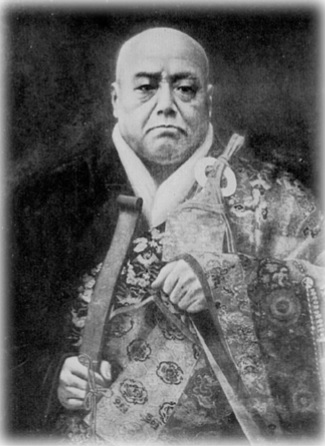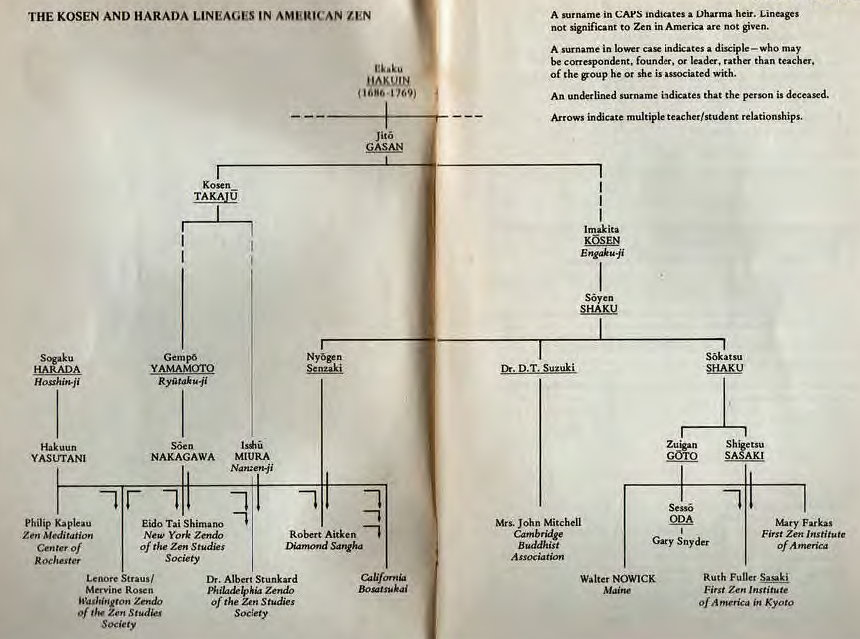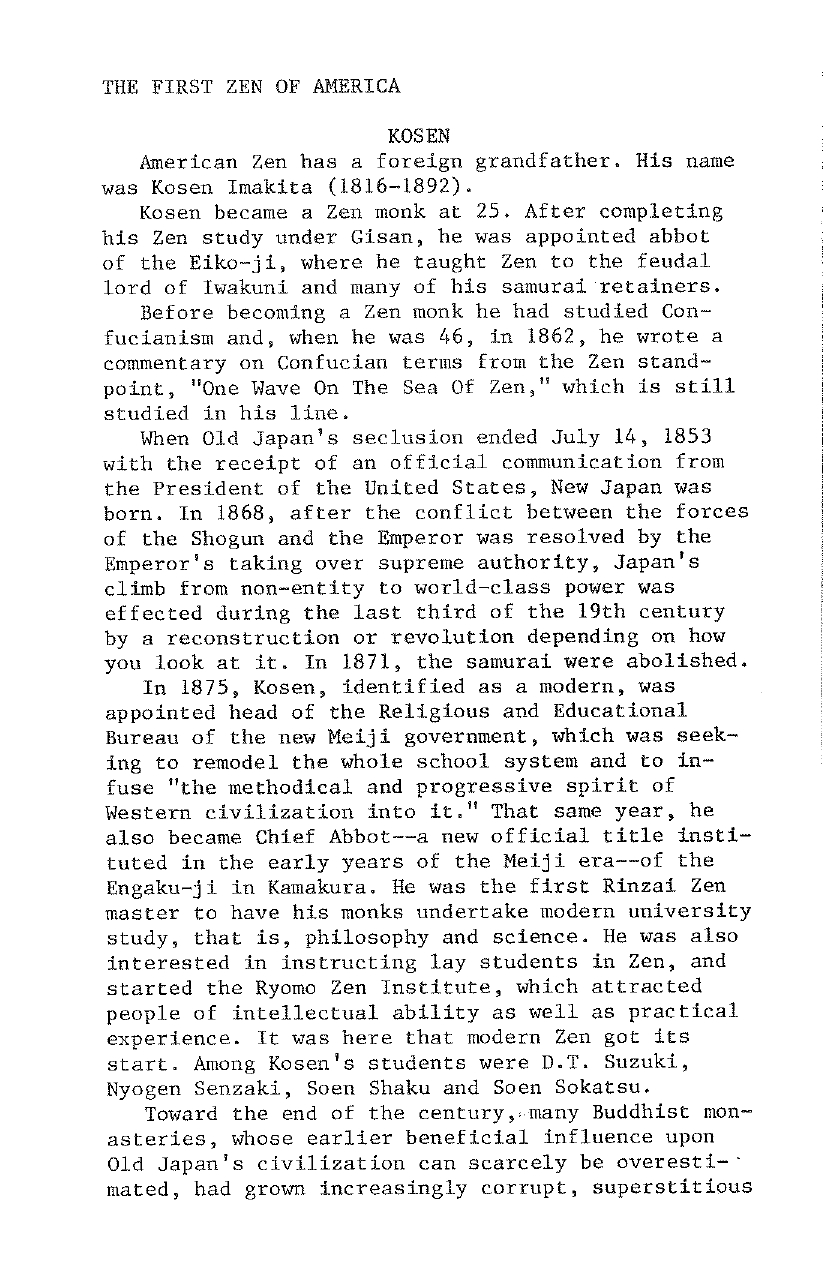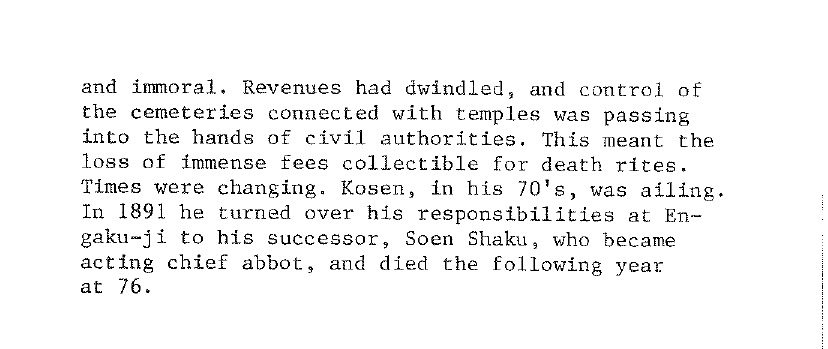ZEN MESTEREK ZEN MASTERS
« Zen főoldal
« vissza a Terebess Online nyitólapjára

今北洪川 Imakita Kōsen (1816-1892)
aka 蒼龍窟 Sōryūkutsu; 洪川宗温 Kōsen Sōon
![]()
http://en.wikipedia.org/wiki/Imakita_Kosen
http://fr.wikipedia.org/wiki/Kosen
Imakita Kōsen 今北洪川 (1816–1892) During the final decades of the early modern period (1600–1868), Confucian scholars intensified their long-standing criticisms of Buddhism, depicting it as immoral and economically wasteful. Imakita Kōsen, an important Rinzai Zen master whose life spanned the transition into the modern era, responded to these challenges by writing an erudite treatise entitled One Wave in the Zen Sea, in which he sought to elucidate the common ground between the two traditions. Imakita was well equipped for this apologetical mission: before taking the tonsure he had taught in a Confucian academy for several years, and continued to study, debate, and lecture on the Chinese classics and commentaries throughout his monastic career. He later became known for his encouragement of lay activities at the Kamakura monastery, Engaku-ji, during the 1870s and 1880s—an initiative continued by his better-known disciple, Shaku Sōen (1860–1919). Completed in 1862, One Wave uses the language of the Confucian classics and the neo-Confucian commentaries to interpret thirty classical passages from a Zen Buddhist perspective. The two excerpts presented here exemplify Imakita's argument for the unity of the two traditions, which is premised on the idea that all human beings are endowed with a true, enlightened nature. In the first, he aligns Mencius' concept of human nature with key Confucian ideas like bright virtue and heaven, as well as with Buddhist notions like enlightenment and suchness. He concludes by emphasizing the importance of experiencing the truth by means of concrete practice (“seeing”), as contrasted with a more intellectual mode of “knowing.” In the second passage, Imakita notes that, contrary to general assumption, the Confucian classics explicitly acknowledge the ineffable quality of the truth; he further argues that this imperceptible dimension is intimately related to the Confucian emphasis on ritual. Imakita goes on to chide Confucian scholars in turn for overlooking the parallel balance in Buddhism, which involves not simply dwelling in emptiness, but also the “strenuous practice” through which one gains entry to the truth.
The one true reality
by Imakita Kōsen 1862, 『禅海一瀾』 [One wave in the sea], original text with modern Japanese trans. by Morinaga Sōkō (Tokyo: Hakujusha, 1987). pp. 231–2, 235.
Translated by by Janine Anderson Sawada
https://cdn.oceanpdf.co/files/JapPhiASou.pdfMencius said: “Those who dedicate themselves know their nature; knowing their nature, they know heaven” [Mencius 7a.1]. We call it heaven. We call it buddha. We call it nature. We call it the bright virtue. We call it bodhi. We call it utmost sincerity. We call it suchness. One reality, many names. The nature was born before heaven and earth. It spans both the past and present, it is constantly here. Its essence is wonderfully and profoundly empty, perfectly brilliant and serene, unfathomably vast and great. Former rulers understood it and were thus able to govern their own persons; they used their remaining energies to govern the empire and the state. Therefore, there have never been sages and worthies who failed to attain it, or Buddhas and patriarchs who failed to attain it. The Book of Changes states: “The humane person sees this and calls it humaneness. The wise person sees this and calls it wisdom” [i.5.26]. That is all.
The sages and worthies promoted moral education in China, India, and Japan. Even though each differed in their approach, and especially in their words, the reality that they grasped in their hearts was completely the same. Mencius understood this reality profoundly and thus was able to identify it, calling it the “nature” and calling it “heaven.” Excellent. The only thing I regret is that he did not say “see the nature.” If the snake exposes its head one inch, one can easily know its length. I always say: “Many know the nature; few see the nature.” If you know the nature, you simply know heaven. If you see the nature, you attain heaven. I hope those who have blood circulating under their skin will not take my words lightly.
……
According to the Doctrine of the Mean, “In the Book of Odes it is said: ‘I cherish your brilliant virtue, which makes no great display in sound or appearance' [Mean xxvii]. The Master said: ‘In transforming people, the use of sounds and appearances is secondary.' The Book of Odes also says: ‘His virtue is as light as a hair.' But a hair can still be compared. ‘The operations of heaven have neither sound nor smell' [Odes, 235, 260]. Precisely.”
These passages are the key to the learning of the sages, the great merit of the school of Confucius. To begin with, the subtle wonder of virtue begins in the realm of no sound and no form, and ends in the three hundred rules of ritual and the three thousand rules of conduct [Mean xxvii]. It is then completely expended in the three hundred rules of the rites and the three thousand rules of conduct, and returns back to the realm of no sound and no form. In this way, the substance and function of the great Way are fulfilled. Its coming and going, and its concealment and manifestation, are marvelous and difficult to express in words. In our Zen School we call it “light and dark intermingled” [Hekiganroku, 51].
If one wishes to attain this samādhi, one must act like a person who is learning to shoot. One slowly practices, then naturally attains the wondrous effect; every shot will effortlessly hit the mark. This is what Confucius meant when he said that at the age of seventy he followed his heart's desire without transgressing the rules [Analects ii.4]. Once one reaches this beautiful place, for the first time one understands that “in transforming people, the use of sounds and appearances is secondary.”
Long ago, Huitang of the Song told Zhu Shiying:
When I first entered the Way, I expected it to be extremely easy. However, after I reached the point of having an audience with our former teacher, Huanglong, I drew back and reflected on my daily affairs, and realized that there were a great many things that contradicted the principles. Finally, after three years of strenuous practice, in spite of suffering extremes of cold and heat, I hardened my resolve and no longer wavered. Later, I in fact understood that every single thing is like the principle. Coughing and spitting and waving one's elbows are the meaning of the patriarch Bodhidharma's coming from the West.17
Confucian scholars tend to say: “The Buddha chooses only emptiness.” In particular, they do not understand that the emptiness of our school is not empty, and that we have a teaching as marvelous as this. Confucius also spoke of the operation of heaven as having no sound, no smell. This, too, is not empty, as I clarified earlier. Is it not stated in the Analects that “When you do not know, to allow that you do not know—this is knowledge” [ii.17]? I pray that scholars will not be like Han Lu chasing a clod of earth.18
17. [Huitang Zuxin (1025–1100) was one of the dharma heirs of the Huanglong stream of the Linji lineage in China that was later brought to Japan by Eisai (1141–1215). The passage cited is from Part 1 of the Zenmon hōkun, and the allusion to Bodhidharma's coming from the West is the basis of a famous kōan.]
18. [Han Lu was a fast-running dog who allegedly chased a hare until he died of exhaustion (Hekiganroku, 43). The sense is that, distracted by trivialities, one misses the essential.]
PDF: Religious Conflict in Bakumatsu Japan
Zen Master Imakita Kosen and Confucian Scholar Higashi Takusha
by Janine Anderson Sawada
Japanese Journal of Religious Studies, 1994 21/2-3, pp. 211-230.
PDF: Political waves in the Zen sea: The Engaku-ji Circle in early Meiji Japan
by Janine Anderson Sawada
Japanese Journal of Religious Studies, 1998 25/1-2, pp. 117-150.
This exploration of the activities and ideas of Rinzai abbot Imakita Kosen (1816-1892) and his lay disciple Torio Tokuan (1847-1905) highlights the sociopolitical dimensions of an important religious network that developed in the Kanto area in early Meiji, and indicates that ordained and lay Zen Buddhists collaborated closely in the ideological movements of the 1880s. It is suggested that the conventional category “conservative,” though generally applicable to these Buddhists, is not always adequate to the nuances of political culture during this period, and that “Zen” as a distinctive idea was not prominent in the nationalistic discourse of the time.
Dharma Lineage
[…]
白隱慧鶴 Hakuin Ekaku (1686-1769)
峨山慈棹 Gasan Jitō (1727-1797)
隱山惟琰 Inzan Ien (1751-1814)
太元孜元 Taigen Shigen (1768-1837)
儀山善來 Gisan Zenrai (1802-1878)
洪川宗温 Kōsen Sōon (1816-1892) [今北 Imakita]

ON IMAKITA KOSEN ROSHI
by Shigetsu Sasaki Roshi (1882-1945)
Wind Bell, Fall 1969, Vol. VIII, Nos. 1-2. pp. 6-7.
What a beast!
How to rope him no one knows,
For he has neither nose nor tail.
Free hangs his halter,
Yet he does not trample
on the fields of seedling rice.
To the sound of a shepherd's flute,
On the home-way he returns,
Meandering through the spring land
Of Ionbutsu.**Gisan Zenrai (儀山善来 1802-1878)
In such fashion Gisan of Sogen-ji acknowledged the attainment of his
disciple Kosen, and as a parting gift presented him with this verse, written in
his bold calligraphy .... He was a man of great stature and of prodigious
strength. Perhaps that is why his teacher likened him to an ox.
Born in 1816 in Fukushima near Osaka, Kosen first studied Confucianism.
But at twenty-five he took the vows of a Zen monk, shaved his head, and
became the disciple of Daisetsu of Sokoku-ji in Kyoto. Later, at his teacher's
request, he went to Gisan, under whom he completed his training in Zen.
His early Confucian studies were indelibly stamped upon his mind, however,
and the Zen of Kosen and his disciples was said to have a certain savor of
Confucianism.
In 1859 he was invited by the feudal lord of Iwakuni to become the abbot
of Eiko-ji, and there he instructed many of this lord's samurai retainers in
the principles of Zen. Later, when the long Shogunate of the Tokugawa
family had come to an end and his country had entered into a new era under
the enlightened rule of the Emperor Meiji, Kosen was summoned to Tokyo
to occupy the position of Superior Overseer of Religious Teaching in the
Educational Bureau of the government. About that time he was also appointed
Patriarch of Engaku Temple at Kamakura, and somewhat later he became the
President of Rinzai Seminary.
Kosen seems to have taken as keen an interest in the promulgation of Zen
among laymen as in the lay-education of Zen Buddhist monks. During the
many years he remained at Engaku-ji that temple became the center of the
lay-study of Zen, and many students from the newly-founded universities
of Tokyo, which was not far distant, flocked to its dynamic master.
Soon after his arrival in Kamakura, Kosen began to hold meditation
meetings in Tokyo in the spring and the autumn, at the request of a group of
distinguished gentlemen, among whom were Tesshu Yamaoka, a famous
fencing master and a member of the Emperor's body-guard, and Chomin
Nakae, one of the first students of the western science of physics. Kosen
called this group Ryōmō Kyōkai (両忘協会), 'Kai' means 'society' or 'association'.
'Ryōmō Kyō' means 'the abandonment of the concepts both of subjectivity
and of objectivity'. The formation of this group was of great importance to
my own life, as will soon be seen.
Gary Snyder:
The line of Rinzai Zen that has come to the West has almost entirely been the work,
the karmic work so to speak, of one man, Kosen Roshi. It was Kosen who opened it
up by saying that Western knowledge is valuable and important for us and we must
leam about the rest of the world and so started the custom of having his
monks go to the university, which was the first time in history this had been
done. Kosen also had an interest in establishing a lay transmission of Zen in
Japan and so his lineage was open outwardly away from the rather rigid
establishment temple Zen; it made them more approachable. And so Soyen
Roshi went to America. The First Zen Institute in New York, Miura Roshi,
myself, Walter Nowick and his group in Maine, D.T. Suzuki, Nyogen Senzaki
also, all go back to that Kosen line. Nakagawa Roshi is not in that line but the
fact that he was invited to America by Senzaki is the same thing. There is
no other line in Japanese Rinzai Zen which has even looked towards the West.

清風生八極 A Pure Wind Animates the Eight Directions
洪川書 Brushed by Kōsen = Imakita Kōsen (今北洪川, 1816-1892)
hanging scroll, sumi on paper 127.3 cm × 32.1 cm.
The fresh breeze of enlightenment reaches all corners of the world, and there is nowhere it cannot be experienced.
Recollections of Kosen
by Peter Haskel
Zen Notes, 2004/4
In an article on Shaku Soen in the current issue of Zen Culture (Zen Bunka), Igami Zenchu, a ninety-one-year-ol d Kamakura Zen priest who is the disciple of one of Soen's heirs, writes about Soen's teacher, Kosen. Married and living in Osaka during the last years of the Tokugawa shogunate, Kosen was a lecturer on Confucianism. One day, lecturing on the "greatness of spirit" that, according to Mencius was the aim of the sage's self-cu ltivation, someone in the audience observed that Mencius' actual greatness of spirit could be realized through the pr actice of Zen. Thereupon, filled with resolve, Kose n left his wife and entered the Kyoto Zen temple Shokokuji, where he began practice under the master "Demon" Daisetsu.
Igami's father studied under Kosen as a novice, and told his son how he noticed that each day, as the master would recite sutras before the altar, he would take so mething from inside his robe, then hold it up and bow, before placing it back in the robe. This seemed strange to the young novice, who asked Kosen, "Master, what is that?" Kosen told him, "Well, it's a secret, but I guess I can tell you: It's a piece of my wife's hair." "Every day," Igami' father said, "the Master bowed and apologized to his wife for leaving her to study Buddhism." "My father told me this," Igami wr ites, "and this is the first time I have revealed it."
Regarding Kosen's death, Igami reports that D.T. Suzuki had taken time off from his studies at the university to do zazen at Kosen's temple in Kamakura. It was group begging day, and all the monks were out doing takuhatsu. Only Suzuki and the inji of the temple were present when Kosen, returning from the to ilet, suddenly collapsed and died.


![]()
PDF: Kōsen
In: Masumi Shibata: Les maîtres du zen au Japon
Éds. G.-P. Maisoneuve & Larose, Paris, 1969,
Ch. XIV, pp. 139-148.